Eric Pallant is a professor of environmental science at Allegheny College in Meadville, Pa., and codirector of the NATO Advanced Study Institute on Integrated Water Resources Management.

Monday, 13 Feb 2006
Kibbutz Ketura, Israel
A Moldovan, two Bulgarians, and three Canadians walk into the desert. It’s like the start of a bad joke, but this is a specific desert — an extreme one, according to local hydrologists. The Arava, in the southern Negev of Israel, is one of the driest deserts in the world, with an average amount of annual precipitation that would barely breach the soles on a pair of sandals.
The Moldovan, Bulgarians, and Canadians are in the company of 41 colleagues, who have come from 14 countries and the Palestinian Authority for a 10-day institute on water resources management. The event is sponsored by NATO, which understands that a future conflict in the Middle East — heck, in many places on the planet — could arise over natural resources. And water is the most embattled liquid, after oil.
I organized this institute with Clive Lipchin of the Arava Institute for Environmental Studies. The organization is a liberal survivor of the 1990s, when peace between Israel and its neighbors seemed imminent and environment and peace groups sprouted like spring flowers. Arava is located on Kibbutz Ketura, a small communal village generating income from growing voluptuous medjool dates, farming fish in cages floating in the Red Sea about 35 miles from here, and raising cows that produce the best chocolate milk in Israel. On many mornings, before the desert winds flow down the Syrio-African rift valley, the aroma of desiccating cow manure blankets the kibbutz.
To kick things off, NATO sent its program director for Scientific and Environmental Affairs, Professor F. Carvalho Rodrigues, to explain why an organization formed during the Cold War to protect Europe from the Warsaw Pact had become a funder of a conference in Israel on water use in the Middle East. Carvalho, built like Luciano Pavarotti, sported a black suit and floral bowtie beneath a coal-black beard. He said the challenges to NATO’s core countries and partners (there are 56 nations now) “have been transformed from national security to broadly defined social security.” NATO now worries about failures in transportation, energy, communications, and what Carvalho calls “life support systems”: water, air, soil, and climate.
Immediately after Carvalho sat down, we heard “good news and bad news” from David Brooks, a Canadian septuagenarian who is the closest thing to a globally recognized, impartial expert on Middle Eastern water. Brooks said the good news is that water wars aren’t imminent, thanks to reasonably good cooperation among erstwhile enemies. The bad news is that water scarcity is pronounced, and getting worse. The overwhelming majority of surface water in the region is polluted, mostly by raw sewage. Inappropriate disposal of industrial and chemical waste is widespread. Farmers receive water for irrigation at absurdly subsidized prices, and groundwater is being extracted at unsustainable rates.
Brooks predicted that as Middle Eastern populations continue to expand, water shortages would be felt first in food production, nearly all of which depends on irrigation. There wouldn’t be a shortage of drinking water; humans can survive on mere gallons per day. In fact, the average Palestinian consumes just 15 gallons a day — half as much as a Jordanian, a fifth as much as an Israeli, and about one-twentieth as much as a Californian.
We got a hint of things to come when Dr. Samir Hijazin, from the Jordanian Ministry of Water and Irrigation, asked, “How can Israel grow vegetables [and raise cows] in the middle of the desert, when Jordanians and Palestinians have to wait for sporadic water deliveries during the middle of the summer?” To paraphrase David Brooks, water shouldn’t be a cause for war in the Middle East — but it could become an excuse.
Tapped Out
Tuesday, 14 Feb 2006
Kibbutz Ketura, Israel
Nader El Khatib is the Palestinian director of Friends of the Earth Middle East. During most of the year, he meets with his Israeli and Jordanian counterparts to promote environmental protection of the region. During the summer, however, he is a dictator.
Nader lives with his two brothers in a house on the West Bank. There are 35 water tanks on the roof, but inside there is no running water. Speaking softly, he told the participants at this week’s NATO institute, “I become a dictator in my family during the summer, when no rain falls for six or seven months. I am constantly checking that no one in the household is wasting water.”
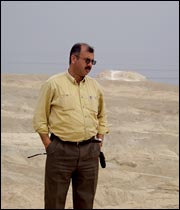
Nader El Khatib.
Photo: Eric Pallant.
In Amman, Jordan, there are water shortages, but at least there is a schedule: water comes every Wednesday. “But in Palestine,” continued Nader, “it could be weeks or months, because Israel controls water allocations to Palestinians on the West Bank. When we were under curfew for 40 days in Bethlehem [during the worst of the intifada], we were constantly worried about water supplies.” The only predictable increase in water provisions on the West Bank comes on Saturday, when religious Jews observe the Sabbath in their West Bank settlement communities and do no work.
To Nader and his fellow citizens, this is the reality of the Israeli-Palestinian conflict. During the peaceful 1990s, Palestinian children were out in the street handing olive branches to Israeli soldiers. After seeing their hopes for an independent Palestine dashed, Nader says it is very hard to tell kids to conserve. “They tell me to get lost, because they do not have enough water to use.”
Nader once participated in a study of water supply to Palestinian cities on the West Bank. In 1997 in Hebron, a city of approximately 110,000, he found most people got water from the piped system only once a week from May to October. This was only enough for 27 liters per day — a little more than six gallons. Picture that many Coke bottles, and imagine using just that amount for cooking, cleaning, washing, and toilet activities. “People have to buy water from suppliers, tanker trucks, and this is an economic burden,” Nader says.
Evgeni Levner, a gray-haired Israeli scientist from the Holon Academic Institute of Technology, listened to Nader’s stories with quiet intensity before finally speaking up. “First of all, I want to say that I never knew any of what Nader just told us. I also want to say that I don’t think we should generalize, we should not create an image of a monster of Israel, nor should we aim to praise it. We should do our very best to find a solution.”
Susana Neto, an urban and regional planner from the Technical University of Lisbon, could not believe Israelis were unaware of Palestinian water shortages. Other Israeli participants confirmed Evgeni’s observation. Israelis don’t know how hard it is. The same can be said for most residents of the developed world.
The participants produced one example of “consciousness raising” from Jordan. A few months ago, there was a campaign in Jordan called “Right to Water.” It was designed to raise awareness among the privileged part of the country’s population about scarcity and lack of water experienced by its poor residents. Participants wondered why there couldn’t be something similar throughout the Middle East.
Jonathon Chenowith from the Center for Environmental Strategy, University of Surrey, England, put his finger on the problem of conferences like these. “The thing is, we are sitting in a small room in a small kibbutz in the middle of the Arava Desert. How can we get the message out beyond our bubble to the rest of the world?”
Now you know.
Dead on Arrival
Wednesday, 15 Feb 2006
Dead Sea, Israel
The public beach on the Dead Sea is filled with gleeful voices: Russian, Italian, Portuguese, Arabic, Turkish, heavily accented English, German, and Armenian. Chris Bowser, a graduate student from Poughkeepsie, N.Y., laughs as he paddles on his back, his feet in the air, his head, shoulders, and half his chest well above the surface.
Frolickers like us can still walk to the public beach, but the walk has gotten longer every year. And reaching the fancy beach at the Ein Gedi Spa now requires a mile tram ride. The snake-like road from spa to beach must be extended annually in order to reach the edge of the Dead — a shrinking body of water that has lost about one-third of its surface area over time.
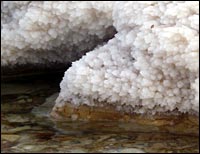
Dead Sea salt.
Photos: Eric Pallant.
The famed sea is actually a terminal lake. Water flows into this, the lowest point on the earth’s surface, from the River Jordan. Its only way out is evaporation. But the last time any fresh water from the Jordan reached this point was in 2005.
As Gidon Bromberg, Israeli director of Friends of the Earth Middle East, puts it, the one-meter-per-year drop in the level of the lake is the best example of international cooperation in the Middle East: “Syria, Israel, Lebanon, and Jordan have all worked together to drain it.”
The Jordan River flows through the Sea of Galilee on its way to the Dead Sea in a nearly straight line from north to south, along the border between Jordan and Israel. North of the Galilee, its tributaries in Syria and Lebanon are dammed. Farther downstream, it is piped to farms in southern Israel. Water is extracted from the Sea of Galilee to supply Israel and Jordan. By the time the river exits the Sea of Galilee to continue south, it consists of brackish water and sewage.
To compound matters, an enormous industrial complex at the southern end of the Dead Sea — known as the Arab Potash Company in Jordan and the Dead Sea Works in Israel — has established evaporation ponds to extract commercially important salts. The factories produce magnesium, bromide, potash, and phosphorus fertilizers for export. Through evaporation, the two companies are responsible for approximately 30 percent of the Dead Sea’s demise.
In the last decade, 800 sinkholes have opened on the Israeli side of the lake. The holes have absorbed highways, bridges, and date orchards. When rainwater or fresh springwater washes away salts in the soil, craters 30 feet deep and wide enough to swallow a bus open without warning.
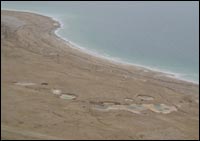
Sinkholes forming on the former lake bottom.
Eduard Interweis, a German ecologist at the Institute for International and European Policy, said it best — while standing next to a sinkhole the size of a condo. “How can I make it clear to my mother? She goes to the store to buy peppers. They come from Israel. Those peppers contain water that once flowed into the Dead Sea and fertilizers manufactured by the Dead Sea Works. How do I explain to her that the salad she prepares for me is killing the Dead Sea?”
The water exported in those vegetables could have been used to support people in Jordan, foster agricultural development in Palestine, preserve endangered riparian species in the Jordan River Valley, or prevent the Dead Sea from drying up.
The Dead Sea won’t disappear. Springs on its floor supply some water that can’t be tapped by surrounding countries. Furthermore, as the lake shrinks, salt concentrations will get so high the rate of evaporation will eventually decline. Nevertheless, in just a few decades, one of the world’s most unique resources — a lake known for millennia for its ability to buoy bodies and spirits — will become a tiny, painfully salty, human-made puddle.
A Sight for Besor Eyes
Thursday, 16 Feb 2006
Kibbutz Ketura, Israel
The Besor River is just like the 14 other streams that begin in the mountains of the West Bank and flow west toward the Mediterranean Sea across the border between the Palestinian territory and Israel. Like the other streams, the Besor is utterly polluted.
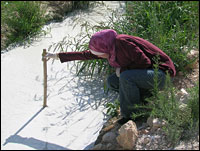
The Besor looking sickly.
Photo: Lior Assaf
Raw sewage from 200,000 people in the Palestinian city of Hebron and the Jewish settlement of Kiryat Arba is dumped into the Besor. At its start, the stream is a milky white slurry, but 60 percent of this sewage will seep into the ground before the stream reaches the sea. On its 70 mile trip, the Besor picks up sewage from the Israeli industrial city of Dimona, turns velvety brown, collects agricultural chemicals from Israeli farms in the northern Negev, gathers solid waste, leaves Israeli territory for the Gaza Strip, and finally empties into the Mediterranean. The Besor is the largest watershed in Israel. In Gaza, it is the only flowing water.
Lior Assaf, an Israeli staff hydrologist at the Arava Institute for Environmental Studies, is part of a team of Palestinians and Israelis working together to model the hydrology and chemistry of the Besor. As happens at meetings like these, he presented a PowerPoint profile of the stream: “Biological Oxygen Demand,” “Index of Biological Integrity,” “Nitrate Concentrations,” and so on. Every measure indicates the stream is deadly. Lior summed up his presentation in Israeli-accented English. “If it smells like sewage and it looks like sewage, then guess what: it’s sewage.”
When he finished his presentation he was attacked. Jordanians, Canadians, and Europeans felt certain he was laying the blame inside the bathrooms of Palestinians for dumping their sewage into the Besor’s headwaters. First, Lior insisted he was only presenting data; the city of Hebron was simply the first to dump its waste. Second, he tried to remind the countries of NATO that Israel also added chemical, agricultural, and human waste. He could not assuage the audience. In the Middle East, even feces (this is a polite publication) is political.
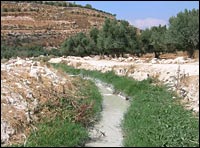
A troubled river helps bring people together.
Photo: Lior Assaf.
Nevertheless, hidden in Lior’s message is a news story bubbling below the line of sight of the world’s television cameras: Palestinian and Israeli scientists are working together. While their leaders hurl vitriol at one another and their armed forces launch missiles, people who care about the environment have steadfastly continued to call, email, and meet.
The Besor River study is not the only cooperative venture in the region to cross borders. The last formal talk of our NATO Advanced Study Institute was delivered by David Lehrer, director of the Arava Institute for Environmental Studies and host for the meeting. David said the goal of the Arava Institute is to bring Jewish and Arab citizens together to protect the environment, “because nature knows no boundaries.”
In one example, college-level students attending the Arava Institute will prepare curricula on transboundary environmental issues during the upcoming semester. They will discuss the religion of birds in high-school classrooms in Eilat, Israel, and Aqaba, Jordan.
The cities of Aqaba and Eilat, which sit side by side on the Red Sea, separated only by the Israeli/Jordanian border, present the first food and rest for nearly a billion migrating birds a year, making it the busiest flyway in the world. The high-school students will be asked to decide whether squacco herons, white storks, little crakes, or tawny pipits choose Judaism or Islam before selecting which side of the border to land on, or whether the quality of the habitat and resources are more important. It proves David’s point. Migrating birds know no boundaries and only cooperative efforts between Jordanians and Israelis will ensure that open space is protected from developers.
There are dozens of cooperative environmental projects in the Middle East, each one rather tiny in the grand scheme of Middle Eastern politics. What they have in common is recognition that everyone here depends on the same dwindling aquifers and breathes the same polluted air. The Middle East is a densely populated, small, dry place, but seen from a bird’s eye view, environmentalists are defying politicians, building bridges across religious, ethnic, and political borders that separate people, but not nature.

